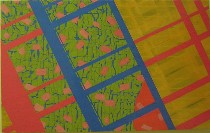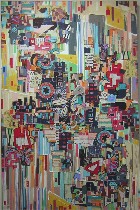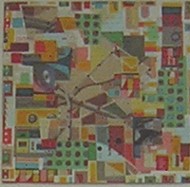
Here are three to see as a group: Clark Gibson’s grids and patterns at Bridgette Mayer until July 17; Eric Mack’s city meets infinity at Sande Webster until July 5; and Robert Straight’s grids and spirals defining deep space at Schmidt Dean, show extended until July 8 (top image, Gibson’s “Tropics,” 17″ x 27″).
 Gibson’s grids and patterns and layers in his solo show, “Kaleidoscope,” exude a sane exuberance and a love of wonderful, summery colors. Of the three, his work is the most grounded in the world in which we live. Gibson, who has been in Philadelphia for the past four years and earned a BA from NYU and a BFA from Parsons, juxtaposes opposites like plaids inspired by architecture’s blocky patterns, flat fields of color, and organic patterns that rise and fall and flow like fabric and the ground upon which we stand (right, Gibson’s “Threaded Towers,” 23″ x 35″).
Gibson’s grids and patterns and layers in his solo show, “Kaleidoscope,” exude a sane exuberance and a love of wonderful, summery colors. Of the three, his work is the most grounded in the world in which we live. Gibson, who has been in Philadelphia for the past four years and earned a BA from NYU and a BFA from Parsons, juxtaposes opposites like plaids inspired by architecture’s blocky patterns, flat fields of color, and organic patterns that rise and fall and flow like fabric and the ground upon which we stand (right, Gibson’s “Threaded Towers,” 23″ x 35″). What makes these heavily glazed, heavily layered oil-on-panel paintings so wonderful, besides the colors, are those organic patterns, quirky and engaging, bringing up images of fabric, animal spots, spidery flowers, stone walls, maps, and confetti. The depth in those patterns stays fairly close to the surface, unless they are embedded in the grids, which seem to go backwards into space forever. Sometimes, irregular fields of flat color–a layer from underneath–push the plaids and patterns apart or vice versa. They also lend a depth to the paintings. The beauty of the work took me by surprise and made me want to see more (left, from top to bottom, Gibson’s “Tropics II,” “Winged Form – Blue,” and “Threaded Form with White Borders,” each 8″ x 10″).
What makes these heavily glazed, heavily layered oil-on-panel paintings so wonderful, besides the colors, are those organic patterns, quirky and engaging, bringing up images of fabric, animal spots, spidery flowers, stone walls, maps, and confetti. The depth in those patterns stays fairly close to the surface, unless they are embedded in the grids, which seem to go backwards into space forever. Sometimes, irregular fields of flat color–a layer from underneath–push the plaids and patterns apart or vice versa. They also lend a depth to the paintings. The beauty of the work took me by surprise and made me want to see more (left, from top to bottom, Gibson’s “Tropics II,” “Winged Form – Blue,” and “Threaded Form with White Borders,” each 8″ x 10″).Gibson, who is in his mid ’30s, took two years to create this show. His process is slow and painstaking, but the result is ebullient.
 Also riffing on the cityscape is Eric Mack, an Atlanta-based artist at Sande Webster Gallery. Mack, who is not yet 30 and is all about how everything links up and is connected, has an outsider intensity that belies his art training in Atlanta. His no-holds-barred work in “Terraterrestrial” contrasts dramatically with the smooth, glossy and controlled work Gibson does. Mack’s mappy mixed-media collage-and-paint canvases pile on bits of paper with words and jazzy rhythms of a sign-filled city and African-influenced patterns(right, Mack’s “TRT-1976,” 70″ x 46″, mixed media on canvas).
Also riffing on the cityscape is Eric Mack, an Atlanta-based artist at Sande Webster Gallery. Mack, who is not yet 30 and is all about how everything links up and is connected, has an outsider intensity that belies his art training in Atlanta. His no-holds-barred work in “Terraterrestrial” contrasts dramatically with the smooth, glossy and controlled work Gibson does. Mack’s mappy mixed-media collage-and-paint canvases pile on bits of paper with words and jazzy rhythms of a sign-filled city and African-influenced patterns(right, Mack’s “TRT-1976,” 70″ x 46″, mixed media on canvas). But city sizzle is not all that Mack seems to have on his mind in these paintings. There’s a suggestion of the city’s place in deep space and a view of all that’s going on from the vantage point of way on high. The calmer spaces and the green spaces set up their own brand of contrast, and give the pulsating city grids room to carry on. Mack names his shows by numbers and letters–and then they also have a number and letter inventory code, a kind of piling on of obsessive codes (Mack’s “SSS-33,” 10″ x 10″, mixed media on paper).
But city sizzle is not all that Mack seems to have on his mind in these paintings. There’s a suggestion of the city’s place in deep space and a view of all that’s going on from the vantage point of way on high. The calmer spaces and the green spaces set up their own brand of contrast, and give the pulsating city grids room to carry on. Mack names his shows by numbers and letters–and then they also have a number and letter inventory code, a kind of piling on of obsessive codes (Mack’s “SSS-33,” 10″ x 10″, mixed media on paper).
 The letter/number approach is also how Robert Straight at Schmidt Dean names his paintings. This approach makes me think of a kind of cataloguing obsessiveness, a desire to keep everything in its place (image, Straight’s “P.390”).
The letter/number approach is also how Robert Straight at Schmidt Dean names his paintings. This approach makes me think of a kind of cataloguing obsessiveness, a desire to keep everything in its place (image, Straight’s “P.390”).
What inspires Straight’s works has less to do with the real world around us and more to do with systems and their magic, their ability to keep control over the chaotic world. Some of the non-grid spaces are filled with marks that remind me of pickup sticks–a relatively chaotic bundle of marks. But the chaos is never allowed to take over; the lines are unbending. All grids and plaids and swooping pinwheels, the work suggests buildings and cities and their inherent magical powers. It also suggests skies and great depth. But it’s a universe that follows strict rules. (Here’s a previous post I wrote on some more fabric-y, less controlled work of Straight’s that I saw previously at Schmidt Dean).
I’m forever intrigued by how similar tactics can evoke such variety of thought and express such different intents. While Gibson seems thoroughly to express earthly concerns and an interest in the here and now, Mack and Straight are seeking to place our world in the universe–or universal forces within our everyday world.









